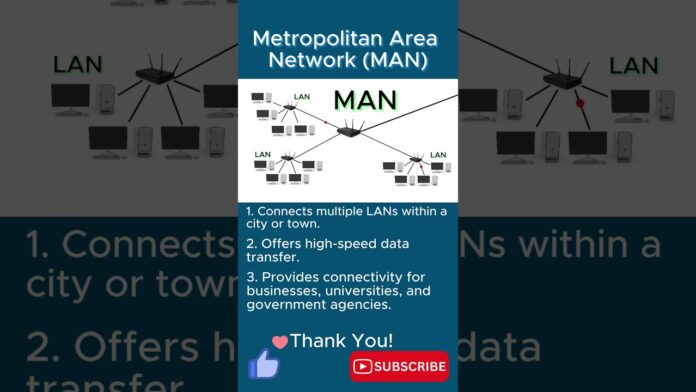In the vast landscape of network connectivity, the Metropolitian Area Network (MAN) serves as the linchpin that bridges cities and urban centers, facilitating seamless communication, data exchange, and resource sharing over expansive geographical areas. As a critical component of modern networking infrastructure, MANs play a pivotal role in supporting businesses, organizations, and communities with high-speed, reliable connectivity. In this article, we embark on a journey to unravel the intricacies of MANs, exploring their significance, architecture, and applications in today’s interconnected world.
Defining the Metropolitian Area Network (MAN):
A Metropolitian Area Network (MAN) is a type of network infrastructure that connects multiple Local Area Networks (LANs) within a metropolitan or urban area, spanning several kilometers to tens of kilometers in radius. MANs are designed to provide high-speed, high-bandwidth connectivity to businesses, government agencies, educational institutions, and other organizations operating within a city or metropolitan region.
Architecture of MANs:
- Fiber Optic Backbone: MANs typically rely on fiber optic cables as the primary transmission medium, leveraging their high bandwidth and long-distance capabilities to interconnect LANs across the metropolitan area.
- Intermediary Devices: Intermediary devices such as routers, switches, and multiplexers serve as the backbone of MAN infrastructure, facilitating data transmission, routing, and traffic management between connected LANs.
- Access Points: Wireless access points may also be deployed in MANs to provide wireless connectivity for mobile devices and remote locations within the metropolitan area, extending the reach of the network beyond wired connections.
Key Features of MANs:
- High Bandwidth: MANs offer high-speed, high-bandwidth connectivity, enabling the rapid transmission of large volumes of data between distributed locations within the metropolitan area.
- Scalability: MANs are designed to accommodate the growing demands for network bandwidth and capacity, allowing for seamless expansion and scalability to meet evolving business and organizational needs.
- Reliability: MANs are engineered with redundancy and fault tolerance mechanisms to ensure reliable network connectivity, minimizing downtime and disruptions in communication and service delivery.
Applications of MANs:
- Enterprise Networking: MANs are widely used by businesses and corporations to interconnect branch offices, data centers, and remote facilities within a metropolitan area, enabling centralized management, data sharing, and collaboration.
- Government Networks: Government agencies and municipal organizations utilize MANs to connect administrative offices, public safety facilities, and critical infrastructure components, facilitating efficient communication and service delivery.
- Educational Institutions: Universities, colleges, and research institutions deploy MANs to interconnect campus buildings, laboratories, and academic facilities, supporting e-learning, research collaboration, and administrative operations.
The Metropolitian Area Network (MAN) serves as a vital artery of connectivity, linking urban centers and communities with fast, reliable communication infrastructure. As cities continue to grow and evolve, MANs will play an increasingly important role in supporting the digital transformation of businesses, organizations, and societies, driving innovation, collaboration, and economic growth across metropolitan regions. With their high bandwidth, scalability, and reliability, MANs empower cities to thrive in the digital age, fostering connectivity and connectivity that transcend geographical boundaries and propel urban development into the future.
